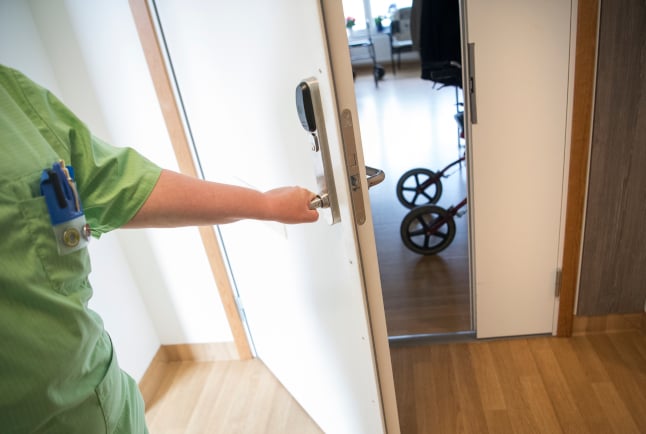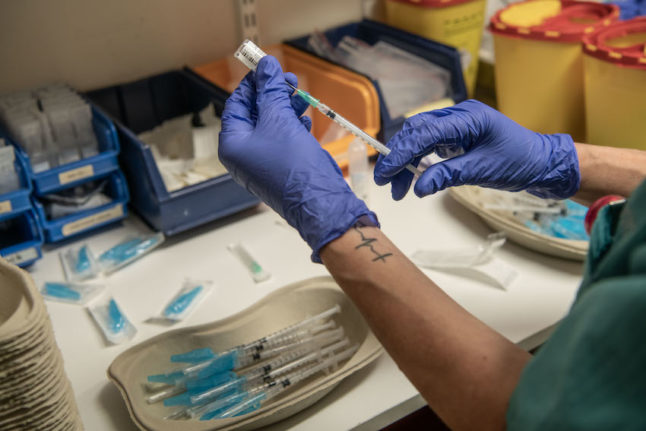At the daily updates from Swedish authorities, the Public Health Agency and National Board of Health and Welfare have described the fall in intensive care cases over the past month as a positive sign.
And yet the number of deaths reported each day is not declining at the same rate, remaining relatively stable at around 70 deaths per day.
This can only be partly explained by the fact that authorities have said death rates are the last figure to show developments.
The median age of people treated in Swedish intensive care units for Covid-19, the disease caused by the coronavirus, is just 60, according to the intensive care register. And of 1,929 people who have so far received intensive care treatment for the virus, just 92 have been aged over 80 (4.7 percent), and only one person over the age of 90 has received it.
Intensive care is physically exhausting for the body, as the register's statistics also show.
Of those aged 80 or older who have had intensive care, only 12 percent of women and 30 percent of men had survived at least 30 days after being admitted to intensive care. Among the 60-79 age group the figures were much higher: 71 percent for women and 64 percent for men, and the survival rates increased further for younger age groups.
So a majority of the elderly who are admitted to intensive care with coronavirus die despite the treatment, although the numbers are so low it's hard to know how accurate these percentages are.
The other big question is whether there are other elderly people in Sweden who could have survived if they had been given intensive care treatment.
“It's not certain at all,” said Lars Sandman, a professor in health and healthcare ethics at Linköping University. “It doesn't necessarily need to be negative to have a selection process. But purely in principle, you can say that there is no reason to de-prioritise people as long as there are availlable intensive care beds, which there seem to be now.”
Sweden has maintained around 20-30 percent spare capacity in its intensive care units, thanks to huge efforts to double the capacity compared to the situation before the outbreak. Stockholm healthcare chief Björn Eriksson has also stated that the instructions to hospitals remain that patients should not be de-prioritised as long as there are intensive care beds available, which there currently are even in the hard/hit region.
“The question is whether, and if so then how many, more people would survive if the selection was done differently, or if you would just be drawing out death,” said Sandman.

Photo: Fredrik Sandberg/TT
Sweden's healthcare watchdog is investigating how Stockholm hospitals have prioritised intensive care admissions during the coronavirus epidemic. All hospitals have been asked to answer questions about how they are prioritising patients, for example whether they are doing so in line with a normal situation or adapted to an extraordinary situation.
Even in normal times, not every seriously ill patient is admitted to intensive care. The treatment on these wards is very tough and if doctors judge that a patient would be unlikely to survive the treatment, for example due to old age or other risk factors, or if they judge that the patient would be put through unnecessary pain without affected the outcome of treatment, they may decide against admitting them to the wards. Systems of this kind are in place in all countries, but the exact criteria for the decision-making process vary.
But some of the reports submitted to the Health and Social Care Inspectorate say that some coronavirus patients who normally would receive intensive care are not receiving it, and that the decision-making process differs between hospitals even within the Stockholm region
The National Board of Health and Welfare has said that age should not determine the treatment a patient receives, and that instead an overall assessment should be made. This came after an internal document from Karolinska University Hospital said that the upper limit for intensive care should be 80.
According to Yngve Gustafson, a professor in geriatrics at Umeå University, it does appear that elderly people have been deprioritised.
“With available capacity at 20-30 percent in intensive care, they have definitely turned away some patients who would have had a chance of survival. But above all, basic hospital care hasn't been offered to the elderly in care homes. In Stockholm only 12 percent of those who were infected in care homes have been admitted to hospital. There, they have received oxygen, nutritional drips, thrombosis prevention treatment and antibiotics, treatment which has often meant they recovered,” he told TT.
MORE ON THE CORONAVIRUS IN SWEDEN:


 Please whitelist us to continue reading.
Please whitelist us to continue reading.
Member comments